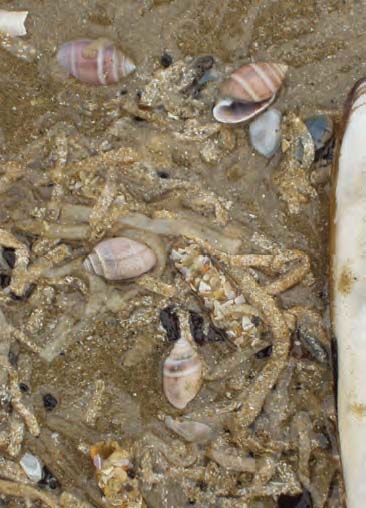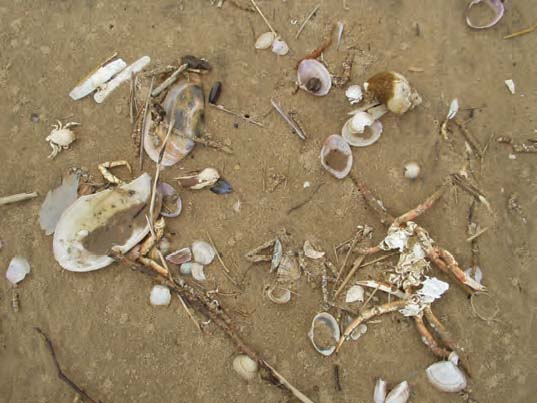|
On Saturday 16th June we met at 10.00 again. Present were Ron Boyce, Tom Clifton, Rosemary Hill, Rupert Honnor, Jan and Nick Light, John Llewellyn-Jones, Celia Pain, Bill and Carol Pocock, James and Caitlin Potter and Janet Sawyer. Sadly Mr Raymond Walker from Swansea was not able to join us. After the Health and Safety briefing we walked down the path towards the causeway. As the terrain was very rough we tended to work in small groups. Jan Light led a cave party of Tom Clifton and Bill Pocock to the base of the promontory. This yielded cave species: Melarhaphe neritoides Leucophytia bidentata, Myosotella denticulata and Otina ovata, much to the delight of the finders! Bill took some shell sand from the cave and looked through it at home, he was very pleased to find Paludinella littorina. In future we shall have to find where this species is living at Rhossili. Nick Light made it to the end of The Worm and back. Probably the prize find was several showy yellow Berthella plumula found by Caitlin and John Potter and John Llewellyn Jones. Ron and Rosemary found Polycera quadrilineata. The NT schoolroom was full of excited people at 16.00 showing off their finds, and Tom Clifton demonstrating how he prepares shipwoms. Celia had trouble compiling a list! Sunday was not an official part of the field meeting, but several of us gathered at Oxwich Bay to see what we could find. Ron Boyce, Rosemary Hill, John Llewellyn-Jones, Celia Pain, Bill and Carol Pocock and Janet Sawyer braved the driving rain. By the time we had walked to the Three Cliffs end of Oxwich Bay the sun had come out and we were too hot! Some of us looked in the caves, hoping to find Otina ovata, but could not find any. I did find one in the shell sand from there. There were lots of sea potatoes Echinocardium cordatum on the lower shore, we looked for Tellimya ferruginosa on them but did not find any, however there were lots in the shell sand. We noticed that thick-lipped dog whelks Hinia incrassata were occurring in pairs, we found that they were inhabited by hermit crabs. There was always a large and a small one together, we surmise that they were mating! A man on the Rhossili beach told us that there had been commercial dredging of razor shells, and certainly there did not seem to be so many razors as there used to be, see also Mullard,J., 2006. Gower. London, Collins. New Naturalist Library, 13- 978-0-00-716066-2. Exactly what effect this will have on populations of molluscs and other marine animals living in Carmarthen Bay remains to be seen. It does not look good. Another threat to Gower biodiversity is the dredging of aggregate on the Helwick Bank that runs parallel to the south coast of Gower. There is removal of the gravel to a depth of two metres, and the remaining sediments are smothered in the silt that has been removed from the gravel. A complete change of the bottom habitat may result. |
2 Berthella plumula from Worms Head
3 Rhosilli Bay with field meeting members
4 Sheltered side of Worms Head
5 Rhosilli Bay tide line |
Report of the Conchological Society field meeting to Rhosilli, Gower, Glamorgan 15 - 17th June, 2007
Issue
16
Page
10

 1 Acteon tornatilis and worm tubes, Rhossili Bay
1 Acteon tornatilis and worm tubes, Rhossili Bay


